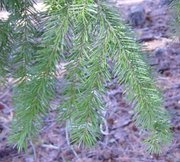Douglas-fir
|
|
| Douglas-fir | ||||||||||||
|---|---|---|---|---|---|---|---|---|---|---|---|---|
| Missing image Douglas_Fir_in_Lassen_VNP-750px.JPG Coast Douglas-fir | ||||||||||||
| Scientific classification | ||||||||||||
| ||||||||||||
| Species | ||||||||||||
|
See text. |
Douglas-fir is the common name applied to coniferous trees of the genus Pseudotsuga in the family Pinaceae. There are five species, two in western North America, one in Mexico and two in eastern Asia. The douglas-firs gave 19th century botanists problems due to their similarity to various other conifers better known at the time; they have at times been classified in Pinus, Picea, Abies, Tsuga, and even (!) Sequoia. Because of the distinctive cones, douglas-firs were finally placed in the new genus Pseudotsuga (meaning "false Tsuga") by the French botanist Carrière in 1867.
Pseudotsuga_menziesii_cone.jpg
The common name honours David Douglas, the Scottish botanist who first introduced the tree into cultivation in 1826. Douglas is known for introducing many North American native conifers to Europe. The hyphen in the common name indicates that douglas-firs are not true firs, i.e. they are not members of the genus Abies.
The douglas-firs are medium-size to large or very large evergreen trees, to 20-100 m tall. The leaves are flat and needle-like, generally resembling those of the firs. The female cones are pendulous, with persistent scales (unlike true firs), and are distinct in having a long tridentine (three-pointed) bract that protrudes prominently above each scale.
A Californian Native American myth explains that each of the three-ended bracts are the a tail and two tiny legs of the mice who hid inside the scales of the tree's cones, which was kind enough to be the enduring sanctuary for them during forest fires.
Species and varieties
By far the best-known is the very widespread and abundant North American species Pseudotsuga menziesii, a taxonomically complex species (Li & Adams, 1989) divided into two major subspecies (treated as distinct species by some botanists); Coast Douglas-fir or 'Green Douglas-fir', on the Pacific coast; and Rocky Mountain Douglas-fir or 'Interior Douglas-fir', in the interior west of the continent. The latter is in turn divided into two varieties, 'Blue Douglas-fir' or 'Colorado Douglas-fir' (var. glauca) in the southern Rocky Mountains, and 'Gray Douglas-fir' or 'Fraser River Douglas-fir' (var. caesia) in the northern Rocky Mountains. The species as a whole is generally known as simply 'Douglas-fir', or as 'Common Douglas-fir'; other less widely used names include 'Oregon Douglas-fir', 'Douglas Tree', and 'Oregon Pine'. It can attain heights of 100 m, second only to the Coast Redwood, and is the state tree of Oregon. The specific name, menziesii, is after Archibald Menzies, a Scottish physician and naturalist who first discovered the tree on Vancouver Island in 1791. Away from its native area, it is also extensively used in forestry as a plantation tree for timber in Europe, New Zealand, southern South America and elsewhere; it is also naturalised in the British Isles, Chile and New Zealand.
Pseudotsuga_01.jpg
Douglas_Fir_buds.jpg
All of the other species are of restricted range and little-known outside of their respective native environments, and even there are often rare and only of very scattered occurrence, occurring in mixed forests; all are listed as being of unfavourable conservation status.
- North America
- Coast Douglas-fir, Pseudotsuga menziesii subsp. menziesii - Conservation status: Secure
- Rocky Mountain Douglas-fir, Pseudotsuga menziesii subsp. glauca - Conservation status: Secure
- Mexican Douglas-fir, Pseudotsuga lindleyana - Conservation status: Vulnerable
- Bigcone Douglas-fir, Pseudotsuga macrocarpa - Conservation status: Lower risk (nt)
- Asia
- Japanese Douglas-fir, Pseudotsuga japonica - Conservation status: Vulnerable
- Chinese Douglas-fir, Pseudotsuga sinensis var. sinensis - Conservation status: Vulnerable
- Narrow-cone Chinese Douglas-fir, Pseudotsuga sinensis var. gaussenii - Conservation status: Vulnerable
- Short-leaf Chinese Douglas-fir, Pseudotsuga sinensis var. brevifolia - Conservation status: Vulnerable
- Yunnan Douglas-fir, Pseudotsuga sinensis var. forrestii - Conservation status: Vulnerable
- Taiwan Douglas-fir, Pseudotsuga sinensis var. wilsoniana - Conservation status: Vulnerable
References
- Peng Li & W. T. Adams. Rangewide patterns of allozyme variation in Douglas-fir. Canad. J. Forest Res. 19: 149-161 (1989).
External links
- Arboretum de Villardebelle - cone photos (http://www.pinetum.org/cones/PScones.htm) Images of cones of selected species
- Gymnosperm Database (http://www.botanik.uni-bonn.de/conifers/pi/ps/index.htm)da:Douglasgran (Pseudotsuga)

